Republic, 12 Chapters, 1949. Starring Tristram Coffin, Mae Clarke, Don Haggerty, House Peters Jr., James Craven, I. Stanford Jolley, Stanley Price, Ted Adams, Marshall Bradford.
A research foundation known as “Science Associates” becomes the target of one “Dr. Vulcan,” a mysterious criminal who’s bent on stealing the atomic-powered weapons that are being developed by the foundation’s scientists. Vulcan hopes to make a fortune by selling these valuable devices to foreign powers, and is quite willing to murder any scientist who tries to stand in his way; he succeeds in killing several members of Science Associates, but unknowingly fails in his attempt on the life of Dr. Millard (James Craven), who pretends to be dead and continues his scientific work in a hidden lab. There, with the help of his trusted colleague Jeff King (Tristram Coffin), Millard perfects a flying “rocket suit”–which the daring King then uses as a means of battling Dr. Vulcan, trying to keep his fellow-scientists’ inventions from falling into the hands of Vulcan’s gang, while also trying to discover the master villain’s identity; it soon becomes apparent that Vulcan must be one of the four other surviving members of Science Associates.
King of the Rocket Men marked the debut of Republic’s last really imaginative and iconic creation: the flying hero–here called Rocket Man—who would figure in three later Republic productions (two serials and a serial/television hybrid) under various names. This first flight of the rocket-suited crimefighter is also the freshest and the best; later treatments would not only rely heavily on stock footage from King of the Rocket Men but also place the hero in science-fiction adventures a little too fantastic for Republic’s ever-shrinking budgets. King, however, manages to be an exciting sci-fi adventure while staying within the bounds of late-Republic believability.

Above: Rocket Man prepares to go into action for the first time.
While most of Republic’s post-war science-fiction serials (The Invisible Monster, Radar Men from the Moon) relied on would-be conquerors for villainy, King’s writers (Royal Cole, Sol Shor, and William Lively) make their heavy more practical; Dr. Vulcan is only interested in using his (and others’) scientific know-how to become wealthy–not in ruling the nation or the world. This treatment of the villain happily saves King’s screenplay from the absurdities that crept into both of the above-mentioned serials—in which power-mad heavies with super-scientific pretensions embarrassingly tried to finance their ambitious schemes by robbing banks or committing other mundane crimes; Vulcan’s scientific schemes are threatening enough to make him a worthwhile villain, but not so grandiose that they can’t be believably carried off on a serial budget.

Above: A Vulcan-caused lab explosion engulfs one of the Science Associates members.
The script also avoids turning into a repetitive tug-of-war over one or more coveted scientific MacGuffins; the first half of the serial does feature a few gadget thefts by the villains, but the narrative remains firmly focused on King’s attempts to trap Dr. Vulcan–and the villains’ attempts to discover Rocket Man’s secret identity. Even after the lethal weapon known as the Decimator is introduced as a new bone of contention at the halfway point, the narrative still alternates between the heavies’ efforts to steal it and the heroes’ ongoing unraveling of the Vulcan riddle. King was the last Republic serial to give its “mystery villain” angle such prominence, and its writers handle the device with above-average finesse, coming up with effective but logical ways to cast suspicion on innocent parties and adding the novel twist of having the heroine and the sidekick briefly suspect the hero of being the villain, which leads to some interesting plot complications in one chapter.

Above: Tristram Coffin (standing) questions the board of suspects at Science Associates; the red herrings, from left to right, are Stanley Price, I. Stanford Jolley, Ted Adams, and Marshall Bradford; House Peters Jr.’s hands are visible on the far right.
King’s fight scenes are smoothly handled by director Fred Brannon, with Tom Steele doubling hero Tristram Coffin and Dale Van Sickel doubling action heavy Don Haggerty; many of the fights receive an additional lift from the presence of David Sharpe, who plays a recurring henchman and adds a few gymnastics to the more grounded brawling of Steele and Van Sickel. Among the standouts are the Chapter One conference-room fight, the fistfight/gunfight in the same room (darkened this time) in Chapter Three, the Chapter Six sidewalk brawl, and the climactic farmhouse fight in the final chapter. Carey Loftin doubles sidekick House Peters Jr., with Bud Wolfe, Bert LeBaron, and Eddie Parker also in attendance. While Steele handles the hero’s fight scenes, it’s Sharpe who doubles Coffin at the beginning and end of each of the flying sequences, using his energetic leaps to make Rocket Man’s takeoffs and landings very convincing; his tumble through a window to begin the aforementioned farmhouse fight is particularly good.
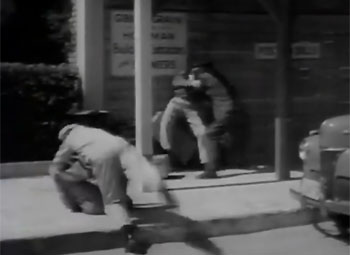
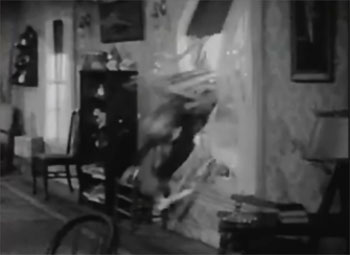
Above left: Tom Steele and Dale Van Sickel battle in the background, while Dave Sharpe (taking Van Sickel’s place as Don Haggerty’s double in this scene) leaps on Carey Loftin in the foreground. Above right: Sharpe, doubling Rocket Man, makes a head-first window entrance.
When Rocket Man is actually in flight, the Lydecker Brothers take over from Sharpe, using the same simple but wonderfully effective dummy-on-wires technique they first utilized in Adventures of Captain Marvel; as in Marvel, the audience can immediately see that Rocket Man is physically present in the air above Iverson’s Ranch and the serial’s other outdoor locations—not artificially superimposed onto a background via animation, process-screen photography, or modern CGI. The Rocket Man is, in fact, even more convincing than Captain Marvel, due to his face-concealing helmet; the barefaced Captain Marvel had to keep his papier-mâché countenance a certain distance from the camera, but Rocket Man can zoom directly and dramatically into the lens without looking phony in the slightest (as in his attack on the villains’ escaping truck in the first chapter).
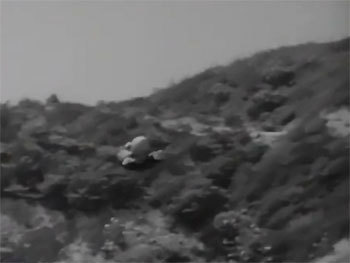

Above: Rocket Man swoops down on his foes (left), while those foes (Don Haggerty and Dave Sharpe) react with understandable surprise (right).
The hero’s pursuit of said truck is the first Rocket Man sequence in the serial–and one of the most memorable, with the hero jetting cross-country to astound the fleeing henchmen and swooping down to fight them in the back of their moving truck; Rocket Man’s subsequent chase after a lethal runaway missile is equally exciting. The hero’s attempt to rescue the heroine from an out-of-control plane in Chapter Five is also good, as is his flight to confront the heavies at her apartment building in Chapter Eight (this sequence features a great downward shot from Rocket Man’s point-of-view, as he flies into the villains’ pistol fire). Other flying scenes—like the airborne chase after a car in Chapter Two—are less spectacular but no less entertaining; in fact, thanks to the superlative effects, it’s interesting to watch the hero in action even when he’s doing something as relatively mundane as flying out to reconnoiter the villains’ hideout.
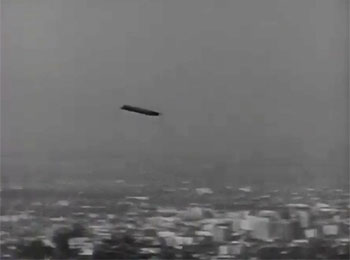
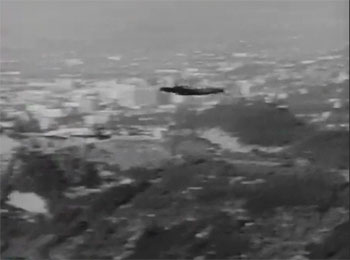
Above: Rocket Man (right) flies to stop a deadly missile (left) high above the San Fernando Valley.
The above-mentioned Chapter Eight scene, with Rocket Man flying head-on into the heavies’ guns, is the serial’s most outstanding chapter ending, although its resolution is fairly uninspired. The hero’s gassing inside his car—as Dr. Vulcan’s voice taunts him—is just as well-shot, almost as memorable, and is resolved more imaginatively. Rocket Man’s fall from the sky after knocking out the missile at the end of Chapter One is good, but it’s rather lazy of the writers to use a variation on it (his fall from a window) only a few episodes later (to close Chapter Four). Most of the other endings are largely made up of well-integrated stock footage, the best of the batch being the Chapter Seven molting-rock sequence—which features some first-rate new shots of the protagonists trapped by flowing lava (originally hailing from SOS Coast Guard and Captain Marvel). Other cliffhangers rely more heavily on borrowed footage—but the only flawed use of stock occurs in the final chapter, which has Dr. Vulcan using the Decimator in an attempted annihilation of New York City; although the frightening shots of floods and collapsing buildings (originally from the RKO feature Deluge) are skillfully blended with the new scenes, the destruction shown is so catastrophic that it’s hard to accept that the city has been saved and has only suffered partial damage, as the script would have us believe.


Above left: The heavies blaze away at the oncoming Rocket Man at the end of Chapter Eight. Above right: A tidal wave begins to wipe out New York City.
Usual villain Tristram Coffin is an offbeat but excellent leading man; his graying hair and shrewdly intelligent face make him extremely believable as a brilliant and experienced scientist, but he’s still physically sturdy enough to be convincing in the action scenes. Suave but authoritative in manner and voice, he’s also very credible when investigating potential Vulcan suspects or slyly concealing his own identity as Rocket Man; he even manages to overcome his naturally aloof screen personality enough to be cheerful (if still urbane) when interacting with his character’s friends. James Craven, like Coffin, does a excellent job of playing against type as the heroic Professor Millard; his confident explanations of pseudo-scientific principles are masterful, and he also does a great job of conveying both a grim determination to track down Vulcan and a brooding frustration with his forcibly sequestered existence.
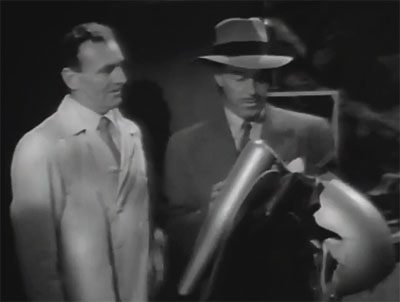
Above: James Craven (left) presents Tristram Coffin with the rocket suit.
Mae Clarke, who plays reporter Glenda Thomas, is even more oddly cast than Coffin; she had been a prominent (and attractive) player in 1930s A-films like Frankenstein and The Public Enemy, but had reached middle age by the time of King’s release. However, what she lacks in youthful good looks she makes up in acting skill, rattling off her go-getting character’s dialogue with an energy and assurance beyond the capabilities of many serial ingénues. House Peters Jr., as Science Associates’ public-relations man, serves as both her partner-in-sleuthing and Coffin’s at different times; in stark contrast to Clarke, he’s so laid-back as to sound decidedly soporific at times—particularly during his long chunk of expository dialogue in the first chapter. He manages to summon up a little more enthusiasm in other scenes, but is generally under-energized throughout; his is easily the weakest of the serial’s performances.

Above: Mae Clarke and House Peters Jr.
Stocky, craggy-faced Don Haggerty–later a first-rate television character actor–is perfect as action heavy Tony Dirken, his cynical smirk and cold voice giving a menacing turn even to non-threatening dialogue. John Holland uses his smooth stage-trained delivery to sound both refined and sinister as the voice of Dr. Vulcan—particularly when taunting two scientist victims in Chapter One or during his similar baiting of the trapped hero in Chapter Ten. The villain is not given a concrete visual appearance to go along with Holland’s excellent vocals, but the shadow on the wall that accompanies his appearances lends the character a touch of panache; overall, he ranks as Republic’s last actually memorable mystery villain.

Above: Don Haggerty receives his orders from “Dr. Vulcan” (back to camera).
The Vulcan suspects are memorable too—the mild-mannered but furtive Ted Adams, the owlishly grouchy Marshall Bradford, the slick and mellifluous-sounding I. Stanford Jolley, and the glowering and rather deranged-looking Stanley Price. Douglas Evans plays the blustering, self-important “Civil Defense Chairman” of New York City in the final chapter; Mathis’ Valley of the Cliffhangers states that this the character was originally designated as the Mayor, but changed to a non-existent functionary, presumably to avoid stepping on any real-life toes—although his boastful references to “this administration” still make him sound decidedly mayoral. The stunt team members play assorted thugs, with Van Sickel also getting a good non-villainous bit as a murdered professor. Dave Sharpe—as mentioned above—reappears almost often enough to qualify as a secondary action heavy, and delivers his few lines quite handily.
Without its flying scenes, King of the Rocket Men would have been a few cuts above the average late Republic serial, but still not terribly memorable. On the other hand, a serial filled with flying scenes but featuring a less well-balanced screenplay might have been memorable, but would also have come off as decidedly silly at times–like most of the Rocket Man’s later screen adventures. However, thanks to the happy combination of those flying scenes and that balanced screenplay—and the efforts of the director, stuntmen, and actors—King of the Rocket Men emerges as a definite winner, easily the best-produced of Republic’s space-age thrillers.
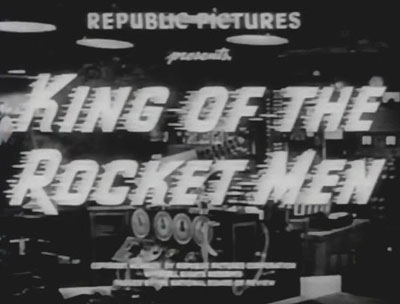

Being the fanatic Republic serial fan that i am ,Its hard to say that I found little to praise about this serial.Tris Coffin, Mae Clarke and House Peters Jr,are miscast as the leads. All seem too old for the heroics. As usual the flying effects steal the show.The final insult being that when New York is being destroyed[courtesy of RKO’s classic The Deluge], our heros and the Mayor make light of the whole thing!Considering the screen play, this seemed [to me anyway] a sour note to end a less than memorable serial. Rating….two stars out of five[ouch!]
One of my ;favorites. I guess I disagree with the above comment almost completely. Coffin made an ideal hero for me. His age made it plausible he could be an accomplished scientist but also mature enough that he could have been a WWII vet and thus tough in a fight and handy with a weapon. I also liked James Craven in his cast against type role. And I don’t join in the general criticism of Mae Clarke. This is not Romeo and Juliet. These are not young lovers. There is no romance. Clarke is a professional woman. Her age is actually an asset in the sense of realism. Look, I’m as much of an old dog as the next guy and like to look at hot young chicks, but I can’t put down using a superior age-appropriate actress rather than a hot but inexperienced ingénue as a weakness
As for the politician not being put out by the destruction of the city, well that part of the town probably hadn’t voted for him anyway and so his chances for reelection were actually improved. More seriously, serials aren’t realism. If realism is going to be dragged in one could condemn them all.
I rate this one in my top ten because of the great flying sequences, the best done prior to the 1977 Superman.
***** out of *****
Thanks to both for your comments, although I obviously agree far more with the second than with the first (that’s what makes a horse race, as they say–or used to)–and particularly with the comments on Coffin and Clarke. The first time I watched this serial, I was definitely disappointed that the girl-reporter role was not played by someone like Peggy Stewart or Aline Towne–but, seeing it again as prep for this review, I was pleasantly struck by how well Clarke handled her dialogue; she has to be one of the most energetic heroines in any post-war serial–and was an especially welcome counterweight to the sidekick here (the more low-key Towne wouldn’t have been enough of a contrast with House Peters Jr.)
King of the Rocket Men runs a dead heat with Secret Service in Darkest Africa a/k/a Manhunt in the African Jungle as my all-time favorite serial. There is a little nostalgia with this serial. I bought the Super 8 Sound feature version, Lost Planet Airmen back in the early 1980s and would show it to my two sons, now grown and gone. Every so often they would cajole me into setting up a white bed sheet in the basement to watch “Rocket Man”. Great memories money can’t buy. I have the DVD version of “King” and watch it once a year. Still love Tristram Coffins corny line to House Peters after Chapter 11’s plot resolution, “Clues Burt, clues.” He knew who Dr. Vulcan was. Yes, the serial was a bit miscast. I’ve seen Tristram Coffin much better as a villain and Mae Clarke IS too old, and House Peters at times needs to wake up, but its the combination of the those great special effects, the Lydecker Brothers working miracles with a zero budget and the premier stunt men Tom Steele and Dale Van Sickel and I’m ready to watch it again.
My favorite of the three Rocket Man films. I was brought to it by the excellent Rocketeer comic, created by Dave Stevens, who used this as an inspiration. Ironically, in the lead up to the release of the Rocketeer movie, independent comic book company Innovation produced a King of the Rocket Men adaptation, by writer/artsts Christopher Moeller. Moeller succeeded in capturing the look, tone and spirit of the serial, while adding little touches, like giving Jeff King a hand-held rail gun, instead of a revolver. At the end of the story, we learn that Jeff King is now working for the government, leading an army of Rocket Men agents, protecting the country from outside threats. He has a breathtaking panel of the group taking flight en masse. Great stuff.
This was the first Republic serial I bought ( VHS) Tris Coffin was an offbeat choice as Jeff King but it works Unlike the colorless actors who later donned the rocket suit Tris made a great hero The effects courtesy of the Lydeckers are great and better than Captain Marvels (the second serial I bought) Maybe not Republics best but definately one of their last great chapterplays
Watched it over again today, first time in a couple of years. Still very impressed with it, not on the top of my lists but is gradually climbing. Cast In my opinion not the greatest in serial history but still very good. Flying scenes were outstanding ( if only Columbia had them in the Superman serials) but that’s another story. Overall enjoyable and held my interest four out of five stars
First, I would like to say that I really like this website!! And it is this website’s “fault” that I got introduced to the world of serials. So: Thank you! 🙂
But now I have a question, and maybe one of you serial guys can help me…
In “Misery” the book by Stephen King the antagonist Annie raves about a cliffhanger scene from “Rocket Man”. She complains that the solution is “not fair”.
Quote from the book:
“The bad guys put Rocket Man […] into a car that didn’t have any brakes, and then they welded all the doors shut. [The car] flew out into space, and then it went down […] and burst into flames, […] and then this ending message came up on the screen that said ‘NEXT WEEK CHAPTER 11, THE DRAGON FLIES’.”
(In the movie Kathy Bates mentions the same scene -> http://www.youtube.com/watch?v=IxFa0w8n8iY )
I really would like to see this particular scene.
Alas, while I could find a car-flies-over-cliff-and-crashes scene, I couldn’t find the one where the doors got welded shut.
Does it exist at all? Maybe in a different non-“Rocket Man”-serial?
Cheers,
Darian
That sounds like a mis-remembering of the Chapter Ten cliffhanger in King of the Rocket Men, where the hero gets trapped in a remote-controlled car whose doors and steering system are controlled by the villain; he can’t get out of the car, or stop it, and seemingly gets killed in a crash at the end of the episode–although next week he’s rescued by the heroine and the assistant hero. The car doesn’t go out into space, though.
Wait a minute. I just watch the Rocketman. Actually, the hero is trapped in a remote-controlled car. Doors are locked. Poison is coming into the car and it looks like the end. However, Mae Charke and Peters see the cab driver jump out of the cab and make a mad car chase to overtake the cab. Peters jumps from his car onto the top of the cab. Blackout. The next scene has Peters in the driver’s seat (wasn’t the cab locked?) stopping the car and pulling out Rocketman (in civilian closes). Where is this “seemingly gets killed in a crash at the end of the episode. . .?”
Offered only to help as others have helped me correct my one thousand mistakes.
Thanks, Dick. Whenever I recall a Republic cliffhanger involving a car, my default memory is that the car crashed. Obviously, I forgot about the poison gas.
Dick, thanks a lot!
Ending of Chapter 10 is really closer to Stephen King’s description, since the doors are locked. They are not welded, either, as indicated by Annie Wilkes, but “those doors can only be unlocked from the outside”. (I assume this is how Peters could enter the cab “from the outside” and sit on the driver’s seat from one scene to the other.)
But you are right. The card does not crash.
So, I think that Mr. King condensed two different chapter ending into one dramatised version.
Because at the end of Chapter 2 (“Plunging Death”) another car, with Mae Clarke inside this time, is radio-controlled. And *this* car drives over a cliff and crushes and actually “bursts into flames”.
Thank you gyus for helping me — even though neither ending has Rocket Man himself being entrapped in the car, I think the “misery-mystery” can be considered as solved.
The only reason I remember the cab incident was because I just finished the serial and was going to read the review – and saw your comment.
Thank you. Yes, this is probably the closest scene to the described one.
Apparently [i]Misery[/i] character Annie Wilkes is not only slightly nuts with an unhealthy tendency to outbursts of rage, but also has a bad memory regarding her beloved Rocket Man 🙂
On balance I enjoyed it, despite the usual “you can’t do that” and “whats?” The flying scenes and the last chapter “through the window, Olympic forward roll and ready to punch” moment were worth the entire chapter. Did anyone notice the back of Rocketman’s jacket was lifted, suggestion a handing cord, in every flying scene? Overall fine acting for the era. Clarke should have refused to wear that hat. Three henchman shooting point blank and missing Rocketman? Loved Rm destroying the wooden doors on the airplane. RM used the ray gun in chapter 1 and reverts to a standard gun – which he keeps in his belt – for the next 11 chapters. And so on until all is well and New York will be rebuilt.
I thought the flying sequences were better than Adventures of Captain Marvel, at least more entertaining, watching the Rocket Man zooming around the canyons of Los Angeles. The fight scenes were equally fun, although viewing them from an adult perspective the multiple punches to the faces of the combatants leaving them unfazed is pretty ludicrous.
With everything going for it, this serial suffers from the same trouble as all Republic product from the mid forties on, deadening lack of characterization. The performances are so basic it’s difficult to maintain interest in the story. It’s a shame Republic forgot about that aspect of filmmaking in their dealing years.
I can’t find an answer anywhere. I hope someone can answer my question. How did they produce that iconic sound when Rocket man turns on his jet pack? It starts with a lone drone, ever increasing in pitch and volume to a crescendo as he blasts off. The most memorable sound that has never been addressed. Hope there is someone out there who knows how the rocket sound was produced.
One of the first serials that I ever watched, and it remains an all-time personal favorite. I fully agree with Old Serial Fan’s comments. The casting works completely for me, as do the flying effects. I’ve seen this one many times over the years, and I’m never disappointed when I see it again. It’s one of the few serials that I wish had more chapters, rather than less. It’s an example of a latter-day Republic that really delivers.